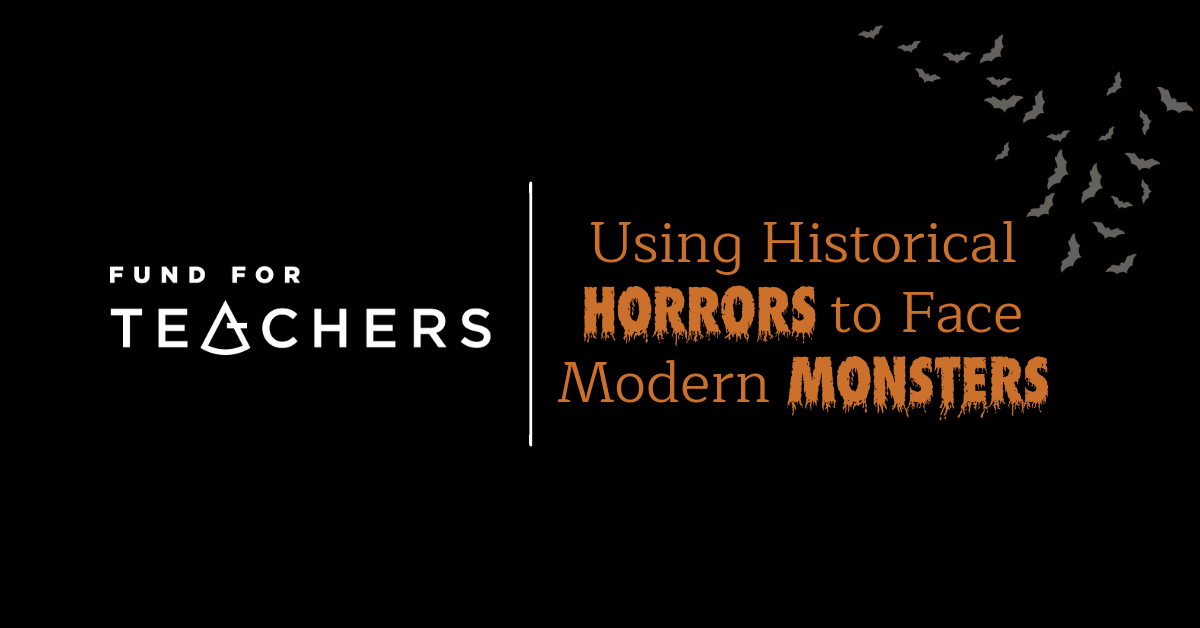Using Historical Horrors to Face Modern Monsters

According to Monster.com’s article “The Scariest Jobs Ranked by Phobia,” teaching is one of the scariest professions out there. FFT Fellows Allison Friedman (Channel View School for Research – Rockaway Park, NY) and Carmela Gandolfo-Birkel (Baldwin High School – Baldwin, NY) decided to lean into fear – specifically by exploring horror.
“Students, teachers, and community members have had a lot to fear in the years since the Covid-19 pandemic: AI, climate change, and gun violence, for instance,” wrote Allison and Carmela in their proposal. “Sometimes these fears can cause people to lash out. It is of vital importance that we teach our students a healthy way to process their fears–both real and imagined. We are interested in guiding our students through examining what does it mean to face fears as an individual and as a society? How do we overcome fears?”
Last summer, the friends leveraged a $10,000 Fund for Teacher grant to collaborate on a fellowship exploring how Britain’s 18th and 19th-century authors were inspired by gothic architecture. Their motivation: Guide students in the crafting of horror stories that metaphorically examine society’s anxieties about the drastic changes caused by the Industrial Revolution.
Their learning included:
- – examining areas that highlight the impacts of the Industrial Revolution that alarmed the public, as well as the gothic architecture and landscapes that inspired authors during this period of drastic changes;
- – considering how people in the 18th and 19th centuries confronted their fears through gothic fantasy and how we and our students can use this to confront our own fears;
- – experiencing locations that are key parts of Britain’s industrial heritage and tell stories of people and landscapes changed by advances in medicine, technology, engineering, and science;
- – seeking examples of gothic architecture and local ghost stories, and;
- – visiting spooky castles and haunted prisons.
As we hear from so many Fellows, the power of place – of actually experiencing sites previously accessed only in books or the Internet – took learning to the next level and will now spark similar learning with their students. “I studied medieval and Restoration literature, but these subjects are not taught in high school,” explained Allison.
“I visited Whitby to learn about Dracula, but stumbled upon a cross dedicated to Caedmon, the first English poet, whose work was the first text I translated while learning Old English. I also came across Aphra Behn’s tomb in Westminster Abbey (one of the first professional women writers). I remembered what I feel passionate about, and now focus on how I can help my students find their own literary loves.”

Stairs worn by the passage of hundreds of years of human steps, beautiful stained glass and tapestry created by artisans from long ago, the tomb of a king, and catacombs containing thousands of nameless dead.
Touching the past.
Students at Baldwin High School and Channel View School for Research are now not only studying Frankenstein and Dracula, but also more modern-day monsters.
“We are incorporating excerpts from gothic novels and an examination of ‘monsters’ of the Industrial Age into our curriculum to show our students the universal themes that remain relevant today,” said Allison. “We are guiding our students through several examples of horror as a reactionary genre inspired by societies that are fearful of change and introducing the concept of how horror is shaped by the zeitgeist.”
After reviewing artifacts from the trip and learning about the original gothic stories, students are studying the American gothic tradition, supported by a trip to Sleepy Hollow to experience one of America’s first ghost stories. Students will then examine 20th-century gothic writers, including Joyce Carol Oates and Shirley Jackson, before analyzing how today’s gothic tales examine current fears.
“In addition to our individual goals [as world history and ELA teachers], we also looked at fear through different lenses on our fellowship,” said Carmela. “By challenging ourselves to face our own fears during ghost walks and visits to local hauntings, we learned how to make what is scary less frightening.”
Allison added: “By understanding the history of the fear of change, we are now developing practical ways to confront these fears in our own time. While some fears are based on fantasy, others come from real threats. Being able to differentiate between the two and process the emotions that result from fear will benefit us along with our students.”
 Back to Blogs
Back to Blogs